Iberia (airline)
Iberia (Spanish pronunciation: [iˈβeɾja]), legally incorporated as Iberia, Líneas Aéreas de España, S.A. Operadora, Sociedad Unipersonal, is the flag carrier airline of Spain,[6] founded in 1927. Based in Madrid, it operates an international network of services from its main base of Madrid-Barajas Airport.[7] Iberia, with Iberia Regional (operated by an independent carrier Air Nostrum) and with Iberia Express, is a part of International Airlines Group. In addition to transporting passengers and freight, Iberia Group carries out related activities, such as aircraft maintenance, handling in airports, IT systems and in-flight catering. Iberia Group airlines fly to over 109 destinations in 39 countries, and a further 90 destinations through code-sharing agreements with other airlines.[7]
 | |||||||
| |||||||
| Founded | 28 June 1927 | ||||||
|---|---|---|---|---|---|---|---|
| AOC # | ES.AOC.001[1] | ||||||
| Hubs | Adolfo Suárez Madrid–Barajas Airport | ||||||
| Frequent-flyer program | Iberia Plus (Part of Avios Loyalty program) | ||||||
| Alliance | Oneworld | ||||||
| Subsidiaries |
| ||||||
| Fleet size | 84 | ||||||
| Parent company | International Airlines Group | ||||||
| Headquarters | Ciudad Lineal, Madrid, Spain[2] | ||||||
| Key people |
| ||||||
| Revenue | |||||||
| Net income | |||||||
| Website | iberia | ||||||
On 8 April 2010, it was confirmed that British Airways and Iberia had signed an agreement to merge,[8] making the combined operation the third largest commercial airline in the world by revenue.[9] Shareholders of both carriers approved the deal on 29 November 2010.[10] The newly merged company, known as International Airlines Group (IAG), was established in January 2011, although both airlines continue to operate under their respective brands.[11]
History
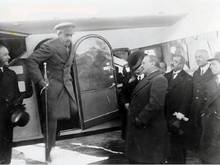
_(5811669732).jpg)
.jpg)
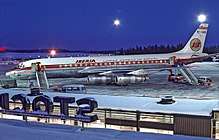
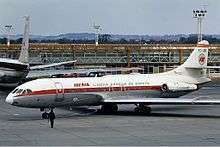

.jpg)
Early years
Iberia, Compañía Aérea de Transportes was incorporated on 28 June 1927 with a capital investment by the financier Horacio Echevarrieta and Deutsche Luft Hansa of 1.1 million pesetas. Flight operations started on 14 December 1927.[12] Within a year, the company was sponsored by the Spanish government to provide postal transport between Madrid and Barcelona. During the dictatorship of Miguel Primo de Rivera, the aviation companies in Spain were combined and became state-controlled as a general interest public utility, coming into effect in early 1928.[13] As a consequence, Iberia was merged into Compañía de Líneas Aéreas Subvencionadas S.A. (CLASSA) and ceased activities as an independent airline on 29 May 1929.[14] The name "Iberia" continued to be registered although the company airline did not have a fleet or commercial operation under its own brand.[13]
In 1937, during the Spanish Civil War, Spanish Navy captain and Director-General of the company Daniel de Araoz y Aréjula[15] received the order from General Kindelán to organize an airline for the air transport in nationalist-held territory during the course of the war.[13] Daniel de Araoz y Aréjula traveled to Germany to get support and material for the restoration of the company as independent airline, thus six Junkers Ju 52 from Deutsche Luft Hansa arrived, which were acquired by Iberia at the end of the conflict, in addition to material to help the operations.[13] As the name "Iberia" was still registered, it was used when operations began in 1937[16] towards the end of the war.[17] During the conflict Iberia was a purely domestic airline, with headquarters in Salamanca the airline operated flights to cities in the nationalist side, Spanish North Africa, Spanish West Africa and Morocco.[18] After the war, at the end of the 1930s, the airline served the Seville–Larache–Cabo Juby–Las Palmas, Barcelona–Saragosa–Burgos–Salamanca–Seville–Tetuan and Palma–Barcelona–Vitoria runs using Junkers Ju 52 aircraft.[19] On 1 May 1939, Iberia operated its first regular service to an international destination as an independent civil airline with a flight Madrid-Lisbon.[20]
In 1940, the government gave the monopoly of national air transport to Iberia (this fact changed 6 years later when the government liberalized the national air traffic for the private airlines),[21] this privilege helped the company to start building as an important international airline, which had not been until then.[22] The airline was nationalised on 30 September 1944 and became part of Instituto Nacional de Industria. The policy of the company was to separate itself from the German orbit to which it had been linked in its first years, and establish relations with the United States in terms of aircraft purchase and supplies of aeronautical material for the operation.[22] Thus that year the purchase of seven DC-3 and three DC-4 was finalized, with the purpose of expanding the network in Europe and accomplishing the company's first transatlantic flight.[22] This was achieved in 1946, Iberia was the first airline to fly between Europe and South America after World War II, using a Douglas DC-4 to operate flights between Madrid and Buenos Aires.[7] This flight was the first of an expansion of flights between Latin America and Europe through Spain carried out by the company, with destinations like San Juan de Puerto Rico, Caracas, Ciudad de México and La Habana. The bad diplomatic relations of the francoist regime delayed some destinations until the beginning of the 50s.[22]
Iberia incorporated four more DC-4s to its fleet during the first half of 1950, enabling both the strengthening of current services and the launch of new ones.[23] With the Pact of Madrid in 1953, visa requirements were eliminated for US visitors to Spain.[24] This stimulated the start of transatlantic flights between Spain and United States the following year. The airline phased in the first of three Super Constellations in June 1954. The aircraft was named Santa María to commemorate Columbus' first voyage[25] and was deployed in the inauguration of the new Madrid–New York service two months later, on 3 August 1954, the same day that Columbus left the port of Palos de la Frontera.[26][27] The amendments to Article 6 of the Convention on International Civil Aviation of 14 June 1954 made in Paris on 30 June 1956 about non-scheduled air services enabled mass tourism using chartered aircraft since allowing European member states to carry out this type of operation with international flights between their territories.[28] This favored the airline given that it had in its territory several highly sought after destinations, mainly those on the eastern and southern Mediterranean coast and in the Balearic and Canary Islands, highly demanded by seaside tourism which began with this type of operation.
In 1959, the Spanish airline Aviaco became a part of Iberia by controlling two thirds of its capital in a capital increase.[29] Aviaco had been created in 1948,[30] after the national air traffic had been liberalized for Spanish private companies in 1946.[21]
In 1961, Iberia had 9 Super Constellation in the fleet, that year came into service the first DC-8-50, the four-engined jet airliner was progressively incorporating until reaching the number of 8 aircraft of the 50 series variant.[31] Iberia was gradually incorporating jets of short and middle range, such as Sud Aviation Caravelle, and Douglas DC-9. The Super Constellations were removed and sold in 1966 and, two years later, three DC-8-63 with more seat capacity were incorporated into the fleet. By 1969, the long range fleet of Iberia was composed by 11 DC-8.[31] In the early 1970s the jumbo jets Boeing 747s and Douglas DC-10s came to the company during an expansion of the intercontinental routes, specially to Central America. By the middle of this decade the airline flew to almost all Latin American capitals. With the expansion in Latin America the company had followed a policy of purchasing shares and establishing agreements with several Latin American airlines such as Compañia Dominicana de Aviación, Aérolíneas Peruanas, PLUNA and Air Panamá Internacional. At first, the intention of this policy could be to create a strong distribution network for intercontinental routes passengers, but as the airline was controlled by the state the Franco regime used this investment policy to get support in Latin America. Iberia gave material, capital and logistical support to those flag-carrier airlines. By 1971, these investments resulted in the loss of 14 million dollars.[32] Iberia also bought the short-middle range trijet Boeing 727-200 in 1971, of which the company had 35 aircraft[33] and was used until 2001 like the other short range jet bought by the company in the late 60's, the Douglas DC-9.[34]
In 1987, Iberia, together with Lufthansa, Air France and SAS Group, founded Amadeus, an IT company (also known as a Global Distribution System) that would enable travel agencies to sell the founders' and other airlines' products from a single system.[35]
This year Iberia planned a fleet renewal in the middle range fleet with the McDonnell Douglas MD-87 and Airbus A320 replacing the Douglas DC-9 and Boeing 727 respectively.[36] In June 1990, the carrier bought 16 Boeing 757s for US$1 billion, including spares and training; twelve more aircraft of the type were taken on option as a part of the deal.[37]
Development since the 1990s
In the 90's, Iberia followed a policy of buying shares of Latin American flag carriers. Its intention was to control the entire Latin American market and become one of the largest airlines on the worldwide scene.[38]
The investments started in June 1990 with the buy of a 30% stake in Aerolineas Argentinas.[38] In 1991 Iberia bought a 45% stake in Viasa for $81million[39] and a 35% stake in Chilean Ladeco[40] The airline continued making progress in setting up Europe's first international airline frequent-flyer programme in 1991, with the creation of Iberia Plus.
In 1994, the bad results of Aerolineas Argentinas, which presented a positive balance in its commercial exploitation but nevertheless hid a significant deficit with losses in non-operating activities, led Iberia to increase its ownership participation to 85%.[41] With this increase in participation, the Argentine state renounced its "golden share", allowing Iberia to have full fiscal control of the company. Iberia began a reduction in the size of the company, a liquidation of the national and overseas offices, and the technical sale of its entire fleet composed of 28 aircraft in a "sale and lease back" operation.[41] Argentine sources indicates that the purchase capital of Aerolíneas Argentinas was charged to its own financial liability.[42] This, together with the aforementioned sales, generated a big controversy, giving rise to criticism of the Argentine government for the privatization of the company. The truth is that during the period that Aerolíneas Argentinas was owned by Iberia (1990–1995), the Spanish airline allocated more than 1200 million dollars in the Argentine flag carrier and kept the airline operating despite the poor results.[41] Meanwhile, the Argentine government refused to invest more capital and expressed its desire to get rid of a large part of its shares.[38] Iberia carried out major reforms in the structure of the company, which by that date was outdated with, among other things, extortionate personnel costs.[43] Some of these changes included the development of a free booking program, the complete computerization of the management system, the introduction of business class on domestic flights, and the creation of a new hub in Ezeiza International Airport for long range regional flights to Latin American destinations.[41] In 1995, before the process of privatization of Iberia, Aerolineas Argentinas was transferred to the Spanish government through INI, which would later become SEPI. In 2001, the Argentine flag carrier was sold to the Spanish company Grupo Marsans.[44]
In 2008, the president of Argentina Cristina Fernández de Kirchner expropriated the company to Grupo Marsans with the symbolic pay of 1 argentine peso ($0.57) and renationalized the airline.[45] In July 2017 the ICSID condemned Argentina to pay 320 million dollars to Grupo Marsans for having paid a lower price than the real value of the company.[46] On 7 April 2010, the president of the Spanish Court of Auditors presented at the Spanish Parliament the figures of the investment in Aerolíneas Argentinas between 1990 and 2001, which was estimated at €2100 million.[47]
The plans to make the Iberia group the dominant airline in the Latin American market also failed in Venezuela. In 1997 the board of directors of Viasa, in which Iberia was the majority, decided to suspend the flights of the company, arguing that the situation was unfeasible.[48] Iberia announcing that the company was not going to continue providing more capital into Viasa if its local partner, the Venezuelan state-owned group FIV, was not going to do the same. By then Iberia had invested more than 250 million dollars in the Venezuelan flag carrier without having any profit.[48] In February 1997, the agreement for the liquidation of Viasa that accumulated a 200 million dollars debt, with a capital of only 2 million dollars, was announced. Iberia and the Venezuelan government had the intention of liquidating the company to avoid bankruptcy. Iberia offered to write off the 150 million dollar debt that Viasa had accumulated to the Spanish carrier in exchange for keeping its fleet of four DC-10s and five Boeing 727s. The agreement included compensation for the staff after the liquidation, which had a cost of 20 million dollars.[49]
Regarding Ladeco, Iberia was a minority shareholder (35%) and did not intervene in its management. Initially Iberia had the intention of achieving the merger of Ladeco with Lan Chile, but Chilean antitrust laws prevented it.[50] Later, in 1995, Lan Chile made a major acquisition of Ladeco shares and acquired 57.6% of the company, this operation was approved by the Chilean antitrust prosecution,[51] and then began a merger process in which Iberia losses some rights acquired during its time as shareholder of Ladeco. In 1997, Iberia sold its shares in Ladeco after had made a $22 million investment.[52]
In 1996, the airline launched its website.[53]
The company ordered 76 aircraft from Airbus in February 1998, which at the time was the largest single Airbus order. The following year it bought Aviaco and inherited that airline's fleet.[54]
By the end of the 90's, Iberia owned as majority shareholder the Spanish airlines Aviaco, Viva Air, Binter Canarias and Binter Mediterráneo, and Latin American airlines Aerolíneas Argentinas, Austral, Viasa and Ladeco.[55]
During 2001, Iberia was privatised and shares were listed on stock exchanges. By 2002, when Iberia celebrated its 75th anniversary, it had carried nearly 500 million people in its history.[56] In July 2004, Iberia announced it had decided to move its Latin American hub from Miami, Florida to San Pedro Sula, Honduras.
On 5 February 2006, Terminal 4 at Madrid - Barajas Airport was turned over to Iberia and fellow Oneworld alliance members. This provided much-needed expansion capabilities for Iberia. Iberia represents around 60% of the airport's traffic. In 2005, the airline and its regional branch Air Nostrum transported 21,619,041 passengers via Madrid – Barajas Airport.
Iberia partially owns a low-cost carrier called Clickair, launched in November 2006.
On 12 November 2009, Iberia confirmed that it had reached a preliminary agreement to merge with British Airways.[57] The merger between the two carriers would create the world's third-largest airline in terms of revenue.[58] On 8 April 2010, it was confirmed that British Airways and Iberia had agreed to a merger, forming the International Airlines Group, although each airline would continue to operate under its current brand.[59]
In November 2012, Iberia announced plans to reduce the number of employees by 4,500 and its fleet by five long-haul and 20 short-haul aircraft.[60]
In 2012, Iberia established its own low-cost airline Iberia Express, which operates short- and medium-haul routes from its parent airline's Madrid hub, providing feeder flights onto Iberia's long-haul network. The airline began operating on 25 March 2012 and shares its head office with Iberia in Chamartín, Madrid.[61] In 2013, the headquarters of both airlines were moved to a new offices in Ciudad Lineal, Madrid, and the corporate images have been changed as part of the renewal process.[62]
Corporate affairs
_01.jpg)
Head office
The company head office is in the inmobiliaria Colonial in the MV49 Business Park in Madrid.[63][64][65] This facility is in proximity to the intersection of the Autopista de Circunvalación M-30 and Avenida de América. In 2013 the company moved its head office from the former Campos Velázquez,[63] in the Salamanca district of Madrid,[66] to save money.[63]
Ownership
On 3 April 2001, Iberia was privatised and included in the IBEX-35 stock index of the Madrid stock exchange. The core shareholders were: Caja Madrid– 23.45%, British Airways 13.2%, SEPI– 5.20%, El Corte Inglés– 2.90%.[67] British Airways raised its stake in Iberia by purchasing American Airlines' remaining shares, reportedly paying £13m for the small shareholding. This increased BA's total stake in Iberia to around 10% and preserved its two seats on the Iberia board.[68]
In July 2008, British Airways and Iberia announced plans to merge, wherein each airline would retain its original brand.[69] The agreement was confirmed in April 2010,[70] and in July, the European Commission and United States Department of Transportation permitted the merger and the two airlines began to co-ordinate transatlantic routes with American Airlines.[71][72] On 6 October 2010, the alliance between British Airways, American Airlines and Iberia formally began operations. At the time it was estimated the alliance would generate an estimated £230 million in annual cost-saving for BA, in addition to the £330 million which would be saved by the merger with Iberia.[73] The merger was finalised on 21 January 2011, resulting in the International Airlines Group (IAG), the world's third-largest airline in terms of annual revenue and the second-largest airline group in Europe.[70][74]
Prior to merging, British Airways owned a 13.5% stake in Iberia, and thus received ownership of 55% of the combined International Airlines Group; Iberia's other shareholders received the remaining 45%.[75]
The merger has been controversial. British Airways operates two funded principal defined benefit pension schemes in the UK. British Airways admits that one of the most serious financial risks it suffers is the challenging pension schemes' combined deficit. The last actuarial valuation was 3.7bn pounds, a value even greater than IAG's capitalisation. In addition and according to the "Pensions Act" for the year 2004, should it be necessary, the United Kingdom's Pension Regulator could force Iberia or IAG to give additional financial support to British Airways' retirement pension schemes. In its "Annual Report and Accounts Year ended 31 December 2011" BA declared that "negative movements in pension asset values and financial returns from these assets may increase the size of the pension deficit".[76]
As of December 2013, the airline had over 18,000 employees.[77]
Due to Brexit, Iberia has been forced to prove that it is still a Spanish airline, despite being merged with British Airways. The consequence for not doing so is their potential inability to fly within the European Union.[78]
Subsidiaries and alliances
Iberia has a 9.49% stake in low-cost carrier Vueling which is based near Barcelona, with parent company IAG owning the remaining 90.51%. This was done to ensure that IAG does not have 100% of the shares in Vueling, but that the shares are split between its divisions. Iberia also has a 0.95% share in Royal Air Maroc.[7]
Iberia is allied with American Airlines, Qantas, Avianca and British Airways, and it was allied with Grupo TACA. On 1 September 1999, the company joined the Oneworld alliance.[79]
Iberia formerly owned Aviaco, which operated most domestic routes. It was founded on 18 February 1948 and operated until 1 September 1999. Iberia also owned Binter Canarias, until the Spanish government began the privatisation of the subsidiary. Hesperia Inversiones Aéreas bought the airline from Iberia in July 2002. A second airline using the Binter name, Binter Mediterraneo, was formed as a subsidiary of Iberia in 1988 with routes from Melilla to Málaga, Almeria, Valencia and in its last year, with Madrid.[80] The airline was acquired by Air Nostrum in 1998 and merged into its operations, at that time the airline had a fleet of CN- 235.[81]
Iberia was a founding partner in the computerised air ticket reservation system, Amadeus, with an 18.28% stake .[82] Iberia is also active as a tour operator through its Viva Tours[83] and Tiempo Libre units,[84] and with Cacesa, it supplies parcel shipment services.[85]
In addition, Iberia is an aircraft maintenance company, servicing its fleet and those of another 48 companies, including some leading European airlines.[86] Iberia is a supplier of aircraft handling services at all Spanish airports and two in Equatorial Guinea; its airline clients number more than 200 and has 7300 employees.[87]
Destinations
Codeshare agreements
As of September 2018, Iberia had codeshare agreements with the following airlines:[88]
- American Airlines
- Avianca
- Bulgaria Air
- British Airways
- Cathay Pacific
- Copa Airlines
- Czech Airlines
- El Al
- Evelop Airlines
- Finnair
- Hainan Airlines[89]
- Interjet
- Japan Airlines
- LATAM Brasil
- LATAM Chile
- LATAM Ecuador
- Qatar Airways
- Royal Air Maroc
- Royal Jordanian
- S7 Airlines
- Ukraine International Airlines
- Vueling
Fleet
Current fleet
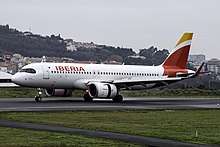
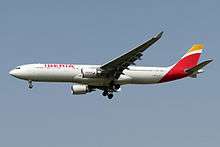
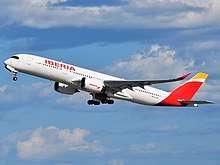
As of February 2020, the airline's fleet consists of the following aircraft:[90]
| Aircraft | In service | Orders | Passengers | Notes | |||
|---|---|---|---|---|---|---|---|
| B | E+ | E | Total | ||||
| Airbus A319-100 | 11 | — | 14 | — | 102 | 116 | |
| 34 | 84 | 118 | |||||
| Airbus A320-200 | 14 | — | 18 | — | 144 | 162 | |
| Airbus A320neo | 6 | 12[91] | TBA | ||||
| Airbus A321-200 | 11 | — | 50 | — | 124 | 174 | |
| Airbus A321neo | — | 4 | TBA | ||||
| Airbus A321XLR | — | 8[92] | TBA | Deliveries from 2023.[92] | |||
| Airbus A330-200 | 12 | — | 19 | — | 269 | 288 | |
| — | 21 | 293 | 314 | ||||
| Airbus A330-300 | 8 | — | 29 | 21 | 242 | 292 | |
| Airbus A340-600 | 16 | — | 46 | — | 300 | 346 | All to be retired by December 2020 and replaced by Airbus A350-900[94] |
| 36 | 23 | 296 | 355 | ||||
| Airbus A350-900 | 6 | 14[95] | 31 | 24 | 293 | 348[96] | |
| Total | 84 | 38 | |||||
Fleet development
At the 2019 Paris Air Show, IAG agreed to purchase 14 Airbus A321XLR aircraft, 8 for delivery to Iberia and 6 to Aer Lingus, with options for a further 14 of the aircraft.[97]
Former fleet
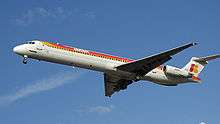
.jpg)
Over the years, Iberia operated the following aircraft types:[98][99]
| Aircraft | Introduced | Retired |
|---|---|---|
| Airbus A300 | 1981 | 2002 |
| Airbus A340-300 | 1996 | 2016[100] |
| Boeing 727-200 | 1972 | 2001 |
| Boeing 737-300 | 1988 | 1990 |
| Boeing 737-400 | 1998 | 2001 |
| Boeing 747-100 | 1970 | 1981 |
| Boeing 747-200 | 1972 | 2005 |
| Boeing 747-300 | 2000 | 2005 |
| Boeing 747-400 | 2004 | 2006 |
| Boeing 757-200 | 1993 | 2008 |
| Boeing 767-300 | 1998 | 2001 |
| Bristol 170 Freighter Mk.31 | 1953 | 1963 |
| Convair 440 | 1957 | 1972 |
| de Havilland DH.89 Dragon Rapide | 1934 | 1953 |
| Dornier Do J Wal | 1935 | 1936 |
| Douglas DC-1 | 1938 | 1940 |
| Douglas DC-2 | 1935 | 1946 |
| Douglas DC-3 | 1944 | 1973 |
| Douglas DC-4 | 1946 | 1968 |
| Douglas DC-8 | 1961 | 1983 |
| Douglas DC-9 | 1967 | 2001 |
| Fokker F28 Fellowship | 1970 | 1975 |
| Ford Trimotor | 1930 | 1946 |
| Junkers G 24 | 1929 | 1936 |
| Junkers Ju 52/3m | 1937 | 1957 |
| Lockheed L-1011 TriStar | 1997 | 1998 |
| Lockheed L-1049 Super Constellation | 1954 | 1966 |
| McDonnell Douglas DC-10 | 1973 | 2000 |
| McDonnell Douglas MD-87 | 1990 | 2008 |
| McDonnell Douglas MD-88 | 1999 | 2008 |
| Rohrbach Ro-VIII Roland | 1927 | 1929 |
| SNCASE SE.161 Languedoc | 1952 | 1960 |
| Sud Aviation Caravelle | 1962 | 1987 |
Aircraft cabins
.jpg)
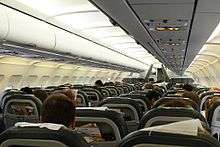
All aircraft in the fleet are configured in a two class layout with Business and Economy cabins. Iberia currently markets three distinct business class variations, depending on flight length. In March 2009, Iberia announced that during the course of 2009–2011 it would renovate its economy class on all its planes as well as designing a new business class for its long haul planes.[101] Iberia was one of the last remaining major airlines to equip all of its intercontinental routes with personal entertainment screens. As of 2016, the Airbus A330-200 and -300, and A340-600 fleets are equipped with personal IFE. In-flight catering is provided by Gate Gourmet.
- Business Class
Business Class is available on Spanish domestic and inter-European flights. Seats are exactly the same as in the economy cabin, but with the middle (B and E) seats blocked off. Business Class tickets also include improved ground service (priority check-in, security, boarding, baggage handling, and lounge access.)[102]
- Business Plus
Business Plus is offered on long-haul flights to the Americas and Southern Africa. Business Plus offers lie-flat seating and international business class amenities.[103]
- Economy
Iberia has moved more to an American, or "a-la carte" model for domestic and European flights, offering a buy on board service called "Tu Menú" in economy for meals, snacks and beverages.[104] Mid-haul flights to Dakar,Moscow, and Tel Aviv as well as long-haul intercontinental flights are fully catered in Economy with the exception of alcohol.[103][105]
Accidents and incidents
As of January 2016, a total of 37 aircraft operated by or for Iberia have been written off in accidents and a shoot-down since 1939. Several Iberia aircraft have also been hijacked. These incidents and accidents include the following:[106]
- On April 19, 1928 a Rohrbach Ro VIII Roland I with registration D-1219 made a hard landing near Ventas de Muniesa, 12 km north of Muniesa, Teruel which resulted in serious damage to the aircraft and caused injuries to the 11 occupants, one of them severely and later died. According to witnesses there was foggy conditions in the area and the plane had given several low passes around the place before landing. The aircraft was flying from Barcelona to Madrid.[107][108]
- During 1939 Iberia lost two trimotor Junkers Ju 52s. On March 16 one crashed due to bad weather in Cabezavellosa on the regular flight from Salamanca to Seville.[109] On December 18 another was mistakenly shot down by British anti-aircraft fire as it passed over Gibraltar on its flight from Tetuán to Seville, when it was mistaken for a German aircraft (the German military used large numbers of Ju 52s in World War II). Three crew and seven passengers were killed.[110]
- On December 23, 1948 a Douglas DC-3 crashed in a foggy and heavy rain conditions in risk of Sierra de Pandols near Bot killing all 27 occupants. After the collision, the fuselage disintegrated and the plane burst into flames following the resulting explosion. The plane fell into Puig Cabals valley. The aircraft was found two and a half hours later.[111][112]
- On October 28, 1957, an engine fire caused a Douglas DC-3 to crash near Getafe killing all 21 occupants.[113]
- On April 29, 1959 a Douglas DC-3 crashed onto Sierra de Valdemeca, Cuenca after being diverted due to bad weather with the loss of all 28 occupants.[114]
- On March 31, 1965 a Convair 440-62, crashed into the sea on approach to Tangiers killing 50 of the 53 occupants. The aircraft stalled at low altitude.[115]
- On May 5, 1965, Flight 401, a Lockheed Constellation, crashed at Los Rodeos Airport at Tenerife after hitting a scraper and tractor during a go-around in foggy conditions. Of forty-nine occupants, thirty passengers and six crew members were killed.[116]
- On November 4, 1967 – Flight 062 a Sud Aviation Caravelle crashed at Black Down Hill Sussex, United Kingdom killing all 37 passengers and crew on board.[117][118]
- On January 7, 1972 Flight 602 crashed into Sa Talia hill in San Jose on approach to Ibiza Airport killing all 104 on board.[119]
- On March 5, 1973, sixty-eight people were killed in a mid-air collision above the French city of Nantes involving an Iberia Douglas DC-9 flying from Palma to London as Flight 504; and a Convair 990 Coronado aircraft, operating as Spantax Flight 400. The Spantax Convair 990 was able to make a successful emergency landing whilst the Iberia DC-9 crashed killing everyone on board. The accident occurred during a French air traffic controllers' strike.[120]
- On December 17, 1973, Flight 933, an Iberia McDonnell Douglas DC-10 registered as EC-CBN, collided with an ALS system of the runway threshold upon landing at Boston Logan after a flight from Madrid Airport. There were no fatalities amongst the 168 people on board, however the aircraft was written off.[121]
- On December 7, 1983, Iberia Flight 350, a Boeing 727 (EC-CFJ), crashed while taking off in dense fog when it collided with Aviaco Flight 134, a Douglas DC-9 (EC-CGS) that had mistakenly taxied onto the runway at Madrid Airport. All on the Aviaco flight perished, and 51 (50 passengers, 1 crew member) of the 93 on board the Iberia flight were killed. Among the casualties was the famous Mexican actress Fanny Cano.[122]
- On February 19, 1985, Iberia Flight 610, a Boeing 727–200, crashed after hitting a television antenna installed on the summit of Monte Oiz while landing in Bilbao, killing 148 people.[123]
- On July 26, 1996 Iberia Flight 6621, a McDonnell-Douglas DC-10-30 flying from Madrid to Havana was hijacked mid-flight. The hijacker, a Lebanese national named Ibrahim Saada demanded the flight be diverted to Miami International Airport. No one was hurt and the aircraft later landed at Jose Marti International Airport some hours later. Saada was later apprehended and faced up to 20 years in prison.
- On November 9, 2007 an Iberia Airbus A340-600, registration EC-JOH, was badly damaged at Quito, Ecuador after sliding off the runway at Old Mariscal Sucre International Airport. No injuries were reported. According to Airbus, the aircraft was written off.[124]
References
- "Listado de Certificados de Operador Aéreo (AOC) de avión y helicóptero" (PDF). Agencia Estatal de Seguridad Aérea (AESA). Retrieved 16 July 2019.
- "Iberia legal information". www.iberia.com.
- "Iberia Express CEO Takes Charge Of Parent". Aviation Week. 28 March 2013. Retrieved 1 February 2014.
- "IAG Annual report and results 2016" (PDF). International Consolidated Airlines Group. Retrieved 3 September 2017.
- "IAG Annual report and results 2016" (PDF). International Consolidated Airlines Group. Retrieved 3 September 2017.
- Linda Blachly, Linda Blachly (29 November 2017). "Iberia remodels T4 lounge at Madrid Airport". Air Transport World. Archived from the original on 1 December 2017.
- "Directory: World Airlines". Flight International. 3 April 2007. pp. 91–92.
- "British Airways and Iberia sign merger agreement". BBC News. 8 April 2010. Retrieved 8 April 2010.
- "BA seals long-awaited Iberia deal". Reuters UK. 8 April 2010. Retrieved 8 April 2010.
- "BA Iberia merger gets approval from shareholders". BBC News. BBC News. 29 November 2010. Retrieved 1 February 2014.
- "IAG shares begin trading, replacing BA and Iberia". BBC News Online. 24 January 2011. Retrieved 2 January 2012.
- Press, Europa (27 June 2007). "Iberia celebra mañana 80 años de andadura con una flota de 220 aviones y vuelos a 104 destinos". europapress.es (in Spanish). Retrieved 13 November 2017.
- Vidal Olivares, Javier (2008). Las alas de España: Iberia, líneas aéreas (1940–2005). Valencia: Universitat de València. pp. 48–49. ISBN 978-84-370-8734-4.
- "Compañía de Líneas Aéreas Subvencionadas S.A. (C.L.A.S.S.A.)". 9 December 2004. Archived from the original on 9 December 2004. Retrieved 16 August 2016.CS1 maint: BOT: original-url status unknown (link)
- ABC. "ABC (Madrid) - 27/02/1947, p. 7". hemeroteca.abc.es (in Spanish). Retrieved 6 November 2017.
- "Airline memorabilia: Iberia (1937)". Airline memorabilia. 15 April 2011. Retrieved 24 October 2017.
- ABC (13 July 2008). "Enigma, vuelo Tetuán-Sevilla, 1939 | Domingos | Domingos - Abc.es". ABC.
- "Business as usual. Airline operation in nationalist Spain — Some First-hand Impressions 1938 | 2840 | Flight Archive". www.flightglobal.com. Retrieved 22 October 2017.
- "Airline companies of the World Iberia Airline". Flight. 1583 (XXXV): 428. 27 April 1939.
- "Iberia L.A.E." www.iberia.com (in Spanish). Retrieved 24 October 2017.
- Ministerio del Aire (23 June 1946). "Boletín Oficial del Estado núm. 174, 23/06/1946" (PDF). Boletín Oficial del Estado. pp. 5070–5071 (num. 174).
- Vidal Olivares, Javier (2008). Las alas de España: Iberia, líneas aéreas (1940–2005). Valencia: Universitat de València. pp. 117–121. ISBN 978-84-370-8734-4.
- "Brevities". Flight. LVIII (2184): 500. 30 November 1950. Archived from the original on 2 September 2017.
- "BOE núm. 188, 08/06/1992" (PDF). BOE. 6 August 1992. p. 27479.
- "Super Connies for Spain". Flight. 66 (2372): 59. 9 July 1954.
- "Civil aviation – Brevities". Flight. 66 (2380): 311. 3 September 1954. Archived from the original on 2 September 2017.
- www.iberia.com [press room]. "Iberia marks 60th anniversary of New York flights".
- "Multilateral agreement on commercial rights of non-scheduled air services in Europe signed at Paris on 30 April 1956" (PDF). International Civil Aviation Organization. 30 June 1956.
- Vidal Olivares, Javier (2008). Las alas de España: Iberia, líneas aéreas (1940–2005). Valencia: Universitat de València. p. 124. ISBN 978-84-370-8734-4.
- "World Airline Directory | Flight Archive |1975 | 0538 |". Flight International. 20 March 1975. Retrieved 14 November 2017.
- Vidal Olivares, Javier (2008). Las alas de España: Iberia, líneas aéreas (1940–2005). Valencia: Universitat de València. p. 55. ISBN 978-84-370-8734-4.
- Vidal Olivares, Javier (2008). Las alas de España: Iberia, líneas aéreas (1940–2005). Valencia: Universitat de València. p. 137. ISBN 978-84-370-8734-4.
- El País (20 February 1985). "El 727, el avión más vendido en el último cuarto de siglo" (in Spanish). Retrieved 22 November 2017.
- Ruiz de Guna, Clara (2 August 2001). "El último viaje del avión 'DC-9' de Iberia". Expansión.com (in Spanish).
- "Amadeus History | 1987 | Amadeus is born!". www.amadeus.com. Retrieved 24 October 2017.
- "ABC (Madrid) - 05/12/1987, p. 74". hemeroteca.abc.es (in Spanish). ABC. Retrieved 22 November 2017.
- "News in brief—Iberia buys 757s". Flight International. 137 (4221): 9. 20–26 June 1990. ISSN 0015-3710.
- Comas, José (12 April 1993). "Entre el sueño y la pesadilla". El País.
- El País (10 August 1991). "Iberia se adjudica la aerolínea venezolana Viasa tras la retirada de la holandesa KLM". EL PAÍS (in Spanish). Retrieved 24 October 2017.
- El País (16 April 1991). "lberia compra el 35% de la compañía aérea chilena Ladeco". EL PAÍS (in Spanish). Retrieved 24 October 2017.
- Castaño Guillén, Julián (2006). "La dirección de resultados en las empresas privatizadas. 10.7.2.- Privatización de Aerolíneas Argentinas". Department of Financial Economy and Account. University of Extremadura: 200–203.
- "Una privatización marcada por los conflictos y las denuncias". La Nación (in Spanish). 3 October 2001.
- Mülller, John (8 April 2010). "Una aventura fracasada" (PDF). El Mundo (in Spanish). Archived from the original (pdf) on 11 April 2010.
- "SEPI adjudicó Aerolíneas Argentinas al grupo Marsans". La Nación (in Spanish). 2 October 2001.
- Botinelli, Agustín (18 December 2008). "A 18 años de su privatización, Aerolíneas vuelve al Estado". La Nación.
- "Argentina, condenada a pagar 320 millones de dólares a Marsans por la expropiación de Aerolíneas". ABC (in Spanish). 22 July 2017.
- Yanel, Agustín (8 April 2010). "2.100 millones perdidos en Aerolíneas" (PDF). El Mundo (in Spanish). Archived from the original (pdf) on 11 April 2010.
- Cebrián Echarri, Belén; Vinogradoff, Ludmila (24 January 1997). "Iberia decide que su filial venezolana Viasa deje de volar". El País (in Spanish).
- Cebrián Echarri, Belén; Vinogradoff, Ludmila (19 February 1997). "Gobierno venezolano da marcha atrás y decide liquidar Viasa". El País (in Spanish).
- Cebrián Echarri, Belén (3 February 1997). "Viasa, el último lío". EL País (in Spanish).
- El País (25 August 1995). "Lan Chile compra la mayoría de Ladeco" (in Spanish).
- El País (9 April 1997). "Iberia venderá su 38% en Ladeco" (in Spanish).
- "Descripción de empresa - Iberia". www.iberia.com (in Spanish). Archived from the original on 1 December 2017. Retrieved 25 November 2017.
- Tagliabue, John (4 February 1998). "International Business; Airbus Wins $4 Billion Order From Iberia, Beating Boeing". The New York Times.
- J. Rodgers, Eamonn (1999). Encyclopedia of Contemporary Spanish Culture. London: Routledge. p. 261. ISBN 0415131871.
- "GrupIberia : Más de 75 años volando". Iberia. Retrieved 1 February 2017.
- Milmo, Dan (12 November 2009). "BA merger with Iberia agreed". The Guardian. ISSN 0261-3077. Retrieved 6 November 2017.
- Osborne, Alistair (13 November 2009). "BA-Iberia £4.4bn merger creates Europe's third-largest airline". ISSN 0307-1235. Retrieved 6 November 2017.
- Mulligan, Mark; Clark, Pilita Clark (8 April 2010). "BA and Iberia sign merger agreement". Financial Times. Retrieved 6 November 2017.
- "Iberia to cut 4,500 staff and reduce fleet by 25 aircraft". Flightglobal.com. Retrieved 3 April 2013.
- "Spanish new low-cost airline Iberia Express launched". BBC News. 25 March 2012. Retrieved 3 September 2017.
- Madridiario. "Iberia renueva su imagen corporativa". Madridiario (in Spanish). Retrieved 6 November 2017.
- "Iberia se muda de sede por un "importante ahorro de costes"" (Archive). Preferente. 8 January 2013. Retrieved on August 13, 2014.
- "." Iberia. Retrieved on August 13, 2014.
- "Google Maps". Google Maps. Retrieved 19 April 2016.
- "Legal notice Archived 2011-09-29 at the Wayback Machine." Iberia. Retrieved on 25 February 2010. "IBERIA, Líneas Aéreas de España, S.A. with official address at Calle Velázquez no. 130, 28006 Madrid,"
- "Inicio – Iberia". Grupo.iberia.es. Archived from the original on 25 February 2009. Retrieved 3 April 2013.
- Airliner World January 2007
- Brothers, Caroline (30 July 2008). "British Airways in Merger Talks". The New York Times. Retrieved 30 July 2008.
- "British Airways and Iberia sign merger agreement". BBC News. 8 April 2010. Retrieved 23 October 2011.
- Rowley, Emma (15 July 2010). "EC approves BA alliance with American Airlines and Iberia". The Telegraph. London. Retrieved 15 July 2010.
- Kamal Ahmed (14 February 2010). "British Airways given approval for tie up with American Airlines and Iberia". The Telegraph. Retrieved 15 July 2013.
- "Airlines unveil 'new deal for transatlantic flyers'". The Independent. London. 8 October 2010. Retrieved 8 October 2010.
- "Iberia expects to complete merger with British Airways in January". Daily Nation. 27 October 2010. Retrieved 18 November 2010.
- "BA and Iberia agree merger deal". BBC News. 12 November 2009. Retrieved 23 October 2011.
- "British Airways 2009/10 Annual Report and Accounts". www.britishairways.com. Retrieved 2 September 2017.
- Moores, Victoria (24 July 2014). "Iberia pilots and ground staff agree to job cuts". Air Transport World. Archived from the original on 24 July 2014.
- Brexit's Impact On Aviation: Iberia Must Prove Its Spanish Nationality To Continue Flying In The EU
- "oneworld welcomes Iberia on board - oneworld news". www.oneworld.com. 16 February 1999. Retrieved 2 September 2017.
- HOSTELTUR. "BINTER oferta cerca de 170 vuelos semanales en la programación de verano | Economía". Hosteltur (in Spanish). Retrieved 6 November 2017.
- "Iberia vende Binter Mediterráneo a su filial regional Air Nostrum". www.elmundo.es. Retrieved 6 November 2017.
- Ramón, Alberto Ortín (13 January 2005). "Iberia retendrá un 11% del capital de Amadeus tras la compra". Cinco Días (in Spanish). Retrieved 2 September 2017.
- HOSTELTUR. "Viva Tours se incorpora al programa Iberia Plus | Economía". Hosteltur: Toda la información de turismo (in Spanish). Retrieved 2 September 2017.
- Ministry of Economy Spain (23 June 2003). "Informe del servicio de defensa de la competencia N-03031 Teinver (Marsans) / Tiempo Libre" (PDF): 20 pages. Cite journal requires
|journal=(help) - (TRANSmarket), Alimarket Transporte. "Cacesa relanza su producto". Alimarket.es (in Spanish). Retrieved 2 September 2017.
- "[ Alphabetical Order ] - Iberia Maintenance". www.iberiamaintenance.com. Retrieved 2 September 2017.
- "Facts & Figures". Airport Services. Retrieved 2 September 2017.
- "Our codeshare partners". iberia.com. Centre for Aviation. Retrieved 4 September 2018.
- Hainan Airlines / Iberia begins codeshare partnership from late-Oct 2019
- "Airbus orders and deliveries". Airbus. February 2020. Retrieved 8 March 2020.
- "Iberia parent firms up two A320neo options". ch-aviation. Retrieved 30 July 2019.
- "PARIS: Iberia and Aer Lingus opt for A321XLRs". FlightGlobal. 18 June 2019. Retrieved 18 June 2019.
- Calvo, Luis (26 October 2019). "Iberia comienza a retirar sus Airbus A340-600". Fly News. Retrieved 27 October 2019.
- "Iberia takes over orders for four Aer Lingus A350s". FlightGlobal. 5 April 2019. Retrieved 5 April 2019.
- Caswell, Mark. "Iberia reveals A350 business class seat details". Business Traveller. Retrieved 7 December 2019.
- "A321XLR Steals Paris Show". Airliner World. August 2019: 6.
- "Iberia fleet development listing". Airfleets.net. Retrieved 20 April 2013.
- Customer Summary Through March 2013. Boeing.com.
- ch-aviation.com - Iberia ends A340-300 operations 23 November 2016
- "Iberia renueva su clase business con un asiento totalmente abatible". viajar.elperiodico.com (in Spanish). Retrieved 2 September 2017.
- "Business Class - Iberia". www.iberia.com. Retrieved 17 April 2016.
- "Business Plus - Iberia". www.iberia.com. Retrieved 17 April 2016.
- "Tu Menú." Iberia Airlines. Accessed October 11, 2008.
- "Economy." Iberia. Retrieved on 13 December 2011.
- "Iberia occurrences". Aviation Safety Network. Flight Safety Foundation. Retrieved 26 January 2016.
- ABC (20 April 1928). "ABC (Madrid) - 20/04/1928, p. 25". hemeroteca.abc.es (in Spanish). Retrieved 7 November 2017.
- ECO de Teruel. "Efemerides ¿Que paso tal dia como hoy del año…..?". ecodeteruel.tv (in Spanish). Retrieved 7 November 2017.
- Accident description for Junkers Ju 52/3mge registration M-CABD at the Aviation Safety Network. Retrieved on 26 January 2016.
- Accident description for Junkers Ju 52/3m registration M-CABA at the Aviation Safety Network. Retrieved on 26 January 2016.
- "Descripción del Accidente ASN 23 DEC 1948 Douglas C-47-DL (DC-3) EC-ABK - Gandesa". Aviation Safety Network.
- ABC (24 December 1948). "The 27 passengers of the Madrid-Barcelona aircraft killed after the mahcien crashed near Gadesa" (in Spanish).
- "Technical Report 1957". Aviation Safety Network. 1957.
- "Technical Report 1959". Aviation Safety Network. 1959.
- Accident description for Convair CV-440-62 registration EC-ATH at the Aviation Safety Network. Retrieved on 26 January 2016.
- "Lockheed L-1049G Super Constellation EC-AIN Tenerife-Norte Los Rodeos Airport (TFN)". Aviation Safety Network.
- "Sud Aviation SE-210 Caravelle 10R EC-BDD Blackdown Hill, Haslemere, West Sussex". Aviation Safety Network.
- "Caravelle crash report 1967 | 2154 | Flight Archive". Flight International. 20 August 1970.
- "Technical Report 1972". Aviation Safety Network. 1972.
- "Mid-air collision kills 68". BBC news. 5 March 1973.
- "Technical Report 1973". Aviation Safety Network. 1973.
- ABC (8 December 1983). "ABC (Madrid) - 08/12/1983, p. 33". hemeroteca.abc.es (in Spanish). Retrieved 6 November 2017.
- "Technical Report A-009/1985". Aviation Safety Network. 1985.
- Iberia A340-600 badly damaged after sliding off Quito runway
Further reading
- Javier Vidal Olivares (2003a). "Estado, regulación de los mercados y estrategia empresarial en América Latina: Iberia, Líneas Aéreas de España, en Argentina y Uruguay, 1966–1975". Historia económica & Historia de empresas (in Spanish). VI (1). 1219-3314, 121–150.
- ——— (2003b). El fracaso de la expansión internacional de la aerolínea Iberia en América Latina: los casos de Panamá y República Dominicana,1966–1973. TST. Transportes, Servicios y Telecomunicaciones (in Spanish). 6. 1578-5777, 23–39.
- ——— (2006). "De la internacionalización a la multinacionalización: Iberia, Líneas Aéreas de España en América Latina (1966–2000)". In M. Cerutti (ed.). Empresas y grupos empresariales en América Latina, España y Portugal (1870–2000) (in Spanish). Universidad Autónoma de Nuevo León and Universidad de Alicante. ISBN 970-694-224-6.
- ——— (2008a). "Las alianzas empresariales en la aviación comercial: Iberia, LAE (1950-1978)". Cátedra Corona (in Spanish). 13 (13). 1657-477X, 1–66.
- ——— (2008b). Las alas de España: Iberia, líneas aéreas: de aerolínea de bandera a transportista mundial (1940–2005). Publicacions de la Universitat de València (in Spanish). 13 (first ed.). Valencia. ISBN 978-84-370-7084-1.